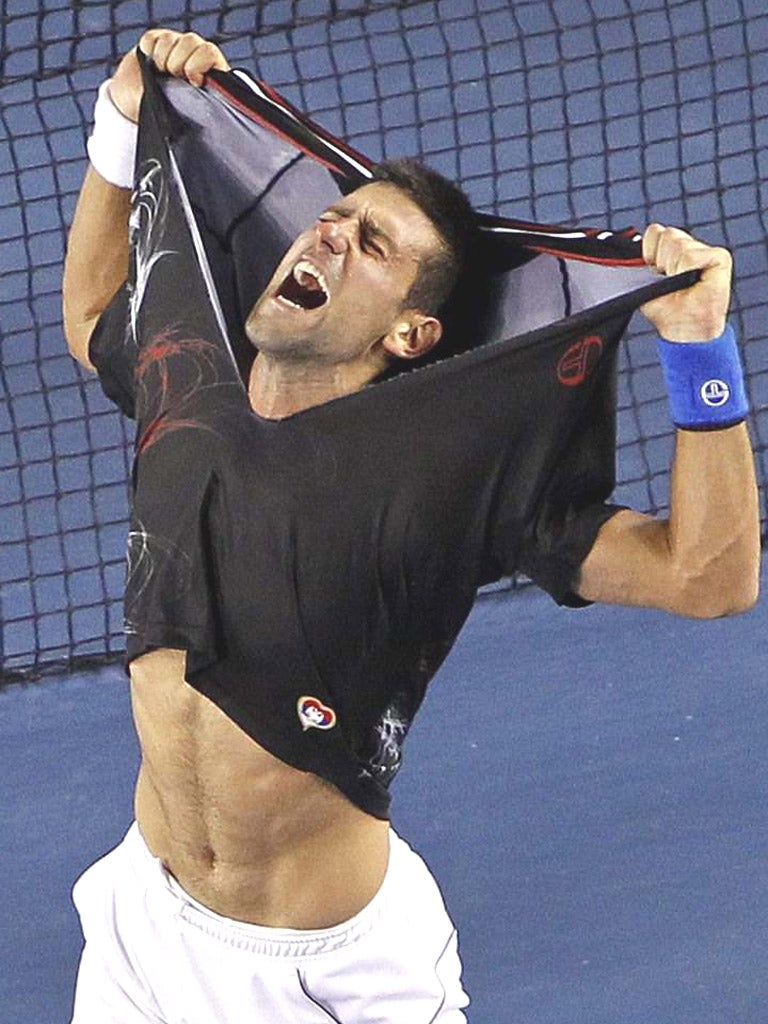Get fit the Djokovic way (it is as hard as it sounds)
The Serb's victory in an epic Australian Open final has been hailed as one of the great feats of sporting endurance. Robin Scott-Elliot reveals the unlikely secrets of his extraordinary stamina

Your support helps us to tell the story
From reproductive rights to climate change to Big Tech, The Independent is on the ground when the story is developing. Whether it's investigating the financials of Elon Musk's pro-Trump PAC or producing our latest documentary, 'The A Word', which shines a light on the American women fighting for reproductive rights, we know how important it is to parse out the facts from the messaging.
At such a critical moment in US history, we need reporters on the ground. Your donation allows us to keep sending journalists to speak to both sides of the story.
The Independent is trusted by Americans across the entire political spectrum. And unlike many other quality news outlets, we choose not to lock Americans out of our reporting and analysis with paywalls. We believe quality journalism should be available to everyone, paid for by those who can afford it.
Your support makes all the difference.Four years ago, Andy Roddick publicly mocked Novak Djokovic's physical frailty. Here, suggested the American to a chuckling audience of tennis reporters in New York, was a fine tennis player but one too ready to raise the white flag when the going got tough.
Roddick was voicing what had been whispered in the locker rooms across the tennis circuit, that the Serb's tendency to call for the trainer was a telling sign of a talented young man who lacked the steel to break up the Roger Federer/Rafael Nadal duopoly. Now Djokovic looks down on the rest, with Roddick one voice among many scrambling to laud his durability in the wake of six hours of high-octane tennis that strengthened Djokovic's grip on the game.
"Absolute war," tweeted Roddick after the final of the Australian Open in Melbourne in which Djokovic defeated Nadal in a match that lasted five hours and 53 minutes, a record for a Grand Slam final. "Physicality of tennis has been taken to another level in the last five years."
Djokovic greeted his victory by ripping off his shirt, an astonishing gesture that captured the moment of a triumph that was as much physical as it was one of sporting prowess. Yesterday Djokovic clutched a wombat – a toy one – in one hand and the trophy in the other for the traditional post-event press conference. "Oh man, I'm tired," he admitted.
The 24-year-old went into Sunday night's match following a similarly sapping encounter on Friday, beating Andy Murray in four hours and 50 minutes. He is the tour weakling no longer, a transformation that has come about through an eclectic combination of hard work – Djokovic's warm-ups are notable for their intensity – a change in diet and a space-age pod that may or may not have any real benefit.
The Australian Open marks the start of the tennis year. It is when the players are at their fittest and freshest, but Djokovic's feat impressed sports scientists for his ability to produce two such marathon performances with minimal recovery time.
"It's a phenomenal effort, a phenomenal aerobic and endurance performance," said Craig Boyd of the Institute of Performance Research at Manchester Metropolitan University.
Diet is one area Mr Boyd and Dr Karl Cooke, the Lawn Tennis Association's sports science manager, highlight in Djokovic's relentless advance from contender to leader of the hungriest pack the sport has seen. In 2010 Djokovic sought the advice of Dr Igor Cetojevic, a nutritionist who holds a diploma from the Indian Institute of Magnetotherapy in Delhi and has studied traditional Chinese medicine. Dr Cetojevic found that Djokovic suffered from Celiac disease and instructed him to cut gluten out of his diet. Since doing so Djokovic has won four Grand Slams.
The most controversial part of Djokovic's improvement has been his occasional use of a CVAC Pod. The £50,000 device resembles something from a Spinal Tap set and is supposed to aid an athlete by simulating high altitude and compressing muscles at rhythmic intervals. The World Anti-Doping Authority takes a dim view of such equipment, although it is not illegal. The scientific community is divided as to its effectiveness. "There is not always a lot of scientific evidence to back up what he is doing," said Dr Cooke. "But he strikes me as someone who is constantly looking at any small thing that can help him last a bit longer or train harder or recover a little bit better."
This is the greatest era in men's tennis, as Federer and Nadal jostle with Djokovic for dominance, and with Murray not far behind. "People are increasingly looking for those margins where they can beat their opponent," Dr Cook said . Djokovic reflected yesterday his triumph. "You're going through so much suffering your toes are bleeding. It's outrageous but you're still enjoying the pain," he said with a smile, the man Roddick once teased for fearing a "common cold".
Fit for purpose: Novak's new regime
The diet
Dr Igor Cetojevic describes himself as an Advanced International Instructor for Quantum Technologies. Novak Djokovic spent a year working with his Serbian compatriot who advised him to adopt a gluten-free diet. That has coincided with a dramatic upturn in his on-court performances.
The pod
Since the US Open in 2010, Djokovic has used his visits to New York to spend time in a CVAC Pod. Designed by a Californian company, it is supposed to boost performance by improving circulation.
Join our commenting forum
Join thought-provoking conversations, follow other Independent readers and see their replies
Comments